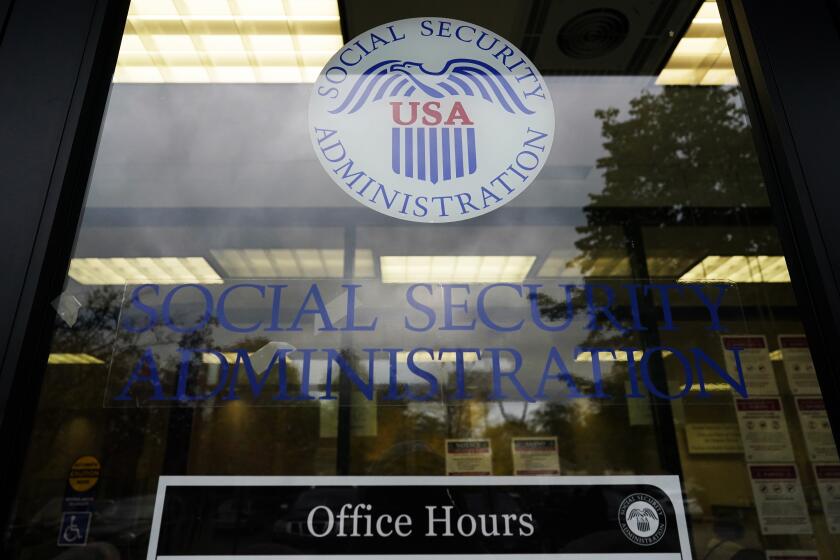
- Share via
- Barring farmers from fields and closing roads, Israel tightens its grip on Syrian borderlands.
- Israel incursions began in December when longtime Syrian leader Bashar Assad was overthrown.
- “We don’t need their aid.” One villager rejected Israeli relief efforts as an insult after the invasion.
RASM AL-RAWADHY, Syria — The Israeli tanks — 15 of them, along with two armored bulldozers — growled as they advanced, their treads churning up the asphalt as they raced into this tiny village, a contingent of paratroopers in tow.
“Mine was the first house they entered. They lined us up — me, my wife, and four kids — against the wall, a soldier for each of us with his machine gun raised,” said Thyab, recounting that night in December when Israeli troops, following the lightning-fast collapse of President Bashar Assad’s regime, stormed into Rasm Al-Rawadhy and other villages on Syria’s western edge.

The soldiers, who said they were rooting out gunmen threatening Israel, rounded up residents and gave them less than two hours to gather belongings and leave. When they were allowed to return 38 days later, villagers said, they found their homes ransacked and half destroyed, and the fledgling signs of a permanent Israeli presence.
“They even took the cow-milking machine. Who does that?” Thyab said. Sitting in his living room, he pointed to graffiti in Hebrew left on the walls by soldiers who had made his home an outpost before they pulled back to Rasm Al-Rawadhy’s edge; “Mom, I love you,” one read; another gave what appeared to be the rotation order for the outpost’s guard detail.
- Share via
For years, Thyab and his neighbors had maintained a uneventful — if nevertheless wary — modus vivendi with Israel in Rasm Al-Rawadhy, which lies just beyond a U.N.-patrolled buffer zone between Syria and parts of the Golan Heights that Israel occupied in 1967.
But now, the Israelis are moving well beyond the 150-square-mile buffer zone. Last week, troops advanced near the city of Tasil, some 8 miles beyond the armistice line and the deepest they’ve reached into Syria since the collapse of the Assad government.
Mayada pointed to a divot picked out of the pavement in front of her parents’ house — the hole left by the bullet when gunmen threw her 85-year-old father on the ground and shot him execution-style in the head.
On a recent day, Thyab and his neighbors kept a wary eye on a pair of military vehicles standing sentinel up the road — one of several Israeli patrols that have become regular fixtures here and in neighboring villages.
“They keep harassing us, asking us if there are gunmen hiding here and if we have weapons,” said Ammar, a shepherd who like most interviewed did not want to give their full name to avoid reprisals. He shouted at his brother to corral the sheep before they strayed too close to the Israeli patrol.

“We spent 14 years of [civil] war dealing with Assad and didn’t get the chance to celebrate getting rid of him,” Ammar said.
“We went from dictatorship to occupation.”
This has become life in southwestern Syria, with the threat of ever-deeper Israeli incursions an omnipresent fear and deadly confrontations with residents feeding the prospect of an all-out war between Israel and Syria’s new authorities.

Israel characterized the incursion near Tasil as a “defensive operation” to destroy an encampment used by the Assad-era army, but it turned deadly when armed locals confronted them. In the ensuing firefight, the Israeli military scrambled drones and launched artillery, killing nine people and wounding more than a dozen others, Syrian health authorities said.
Accompanying the raid were dozens of airstrikes that obliterated major military installations across Syria — all part of an Israeli campaign to preemptively defang Syria’s new authorities.
Israel’s moves reflect a shift in its strategy since Oct. 7, 2023, when the Palestinian militant group Hamas launched an attack that killed around 1,200 Israelis — two-thirds of them civilians — and kidnapped some 250 others. In its wake, Israel hardened its borders with Gaza and Lebanon, expanding outwards to establish demilitarized buffer zones.

On Thursday, Israeli Defense Minister Israel Katz said in a message posted to social media that the strikes in Syria served as a “clear message and a warning for the future.”
“If you allow forces hostile to Israel to enter Syria and endanger Israel’s security interests, you will pay a heavy price,” Katz said, addressing Syrian President Ahmad al-Sharaa by his former nom de guerre, Abu Mohammad al Jolani.
In an earlier speech, he said Israel would remain in the area indefinitely, while Israeli Prime Minister Benjamin Netanyahu said he would not allow forces of the new Islamist-led government to operate south of the capital Damascus.
So far, Syria’s leaders have said they will adhere to the 1974 ceasefire agreement. Fearing more Israeli strikes, government-affiliated factions operating in south Syria transported much of their heavy materiel to Damascus, according to two commanders, while the foreign ministry complained in a statement that last week’s raids were “a deliberate attempt to destabilize Syria and exacerbate the suffering of its people.”
“We’re waiting for the state to tell us what to do. Is it going to be a matter of popular resistance, or is there a government working on the issue?” said a commander with a pro-government faction in the south. He spoke anonymously because he was not authorized to speak to the media.
“We don’t want martyrs to keep on dying. The Israelis have drones, helicopters, tanks, infrared goggles. What do we have? Nothing.”
Meanwhile, signs of Israel establishing a new reality in southwest Syria abound.
Israeli troops have all but commandeered Highway 7, which links to Rasm Al-Rawadhy, forcing cars into arduous detours over narrow dirt tracks and preventing U.N. peacekeeping troops from approaching.
An analysis by William Goodhind, a satellite imagery expert at Contested Ground, an open access research project, shows Israeli troops have cleared land and excavated tracks for a new road along the border that would connect to a number of outposts. The Israeli army announced it would organize hiking tours for intrepid day-trippers into areas inside Syria this month.
The Israelis are the most recent in a series of unwelcome visitors that imposed their presence in southwestern Syria. During the civil war between Assad and the rebels, the area was taken over by Al Qaeda-linked groups and then the extremists of Islamic State before they were dislodged by the Syrian army and its Iran-backed militiamen.
After violence broke out between the current and past regimes in Syria, fearful residents have waded across a river to take refuge in Lebanon.
In Al-Hamidiyah, a village just north of Rasm Al-Rawadhy that still bears the scars of war’s destruction, a squad of Israeli soldiers in a weathered Humvee stopped incoming vehicles to check IDs. Up the hill, enveloped in a late-morning fog, were the barely there outlines of a new Israeli military outpost. Residents complained soldiers restricted their movement and barred them from accessing grazing land for their livestock.
“We keep telling the Israelis: There’s no Hezbollah here. There’s no Islamic State here. They’re all gone. There’s only us,” said a community leader who refused to be named criticizing Israeli troops’ presence for fear of reprisals.
As if addressing an Israeli, he said, “You’re an occupier. You cut me off from my areas, and you don’t want me to complain about you?”
Israel has used both carrot and stick in dealing with communities in the south. It said it would open up job opportunities for the area’s Druze minority, who share ties with Israeli Druze communities and have so far refused to fully integrate under Al-Sharaa’s Islamist-dominated government. Elsewhere, Israel offered aid packages — a boon for the poverty-stricken population but one that many rejected.
“We have a government and a state. We don’t need this from the Israelis,” said Thyab. Besides, he added, aid packages could hardly compensate for the damage troops inflicted on his home.
“I lost more than $10,000 worth of equipment,” he said. “They think a couple of boxes of rice are going to be enough? You want to compensate, come rebuild everything you destroyed.”

Most villages have grudgingly acquiesced to Israel’s presence, but some remain defiant. Last month in Koawaya, a hamlet wedged near Syria’s border with Jordan and Israel, Israeli troops were running patrols to confiscate weapons when local men opened fire to prevent them from entering the village. In response, troops launched drones and an artillery barrage that killed six people, Syria’s Red Crescent said, triggering an exodus of most of the village.
“Any weapons we have are to protect our livestock from wild boars. Let the Israelis stay in their place, we stay in ours, and we won’t have any problems,” said Hani Mohammad, a retired school principal living in Koawaya who lost his daughter in the barrage. He added that he had told his neighbors it was pointless to fight, but the Israeli incursions were intolerable for many people here.
One of them is Maher, a 35-year-old farmer of tomatoes and zucchinis whose land was in the nearby Yarmouk Valley. He now sat on the porch steps of a house on Koawaya’s edge, a few dozen yards from an Israeli patrol, holding a rusty AK-47 and looking grim as his eyes scanned the sky for an Israeli drone buzzing above.
“They’re stopping us from reaching our lands. What am I going to live on?” he said.
Last week, the Israeli military dropped fliers above Koawaya, telling villagers they were forbidden from having arms when they moved around in the village and its environs. It also banned them from accessing the road toward the valley.
“We warn you,” the flier read, “You must follow instructions, to preserve the order.”
More to Read
Sign up for Essential California
The most important California stories and recommendations in your inbox every morning.
You may occasionally receive promotional content from the Los Angeles Times.














